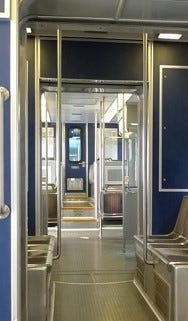“Trams Are Bad for High-Capacity Metro-Style Use”
I have doubted the wisdom of the MTA’s proposed use of a Light Rail Transit (LRT) mode for the Interborough Express (IBX) line and have written before about some of the issues. As the MTA reports have pointed out, “If built, the IBX would see higher daily ridership than nearly any new transit line built in the U.S. over the last two decades.” Such heavy predicted ridership suggests that a “light” rail system would be unsuitable. Recently, more limitations of Light Rail Vehicles (LRVs or trams) have come to my attention.
The MTA proposes to use so-called low-floor LRVs on the IBX line. They have suggested that trains of two articulated cars, carrying a total of 360 people, would have adequate capacity, and that a third car could be added if necessary. The MTA has indicated that LRVs similar to the Kinki Sharyo cars used on the Hudson Bergen Light Rail (HBLR) line are what they have in mind.
I have also noted that Sound Transit line 1 in Seattle uses both Kinki Sharyo cars and similar, more modern Siemens S700 low-floor Light Rail Vehicles. A picture of a representative S700 car, from a Siemens brochure, is shown below:
I took a PATH train to New Jersey and rode the HBLR. I discovered that the ends of each car are higher than the central portions. The specifications identify these railcars as 70% low-floor Light Rail Vehicles. To access 30% of each 90 to 95 foot-long car, a rider must either walk up a ramp and one step (in the Kinki Sharyo cars) or up two steps (in the Siemens S700, as show below, where the step edges are yellow):
When riding the HBLR, I also noted delays in exiting from the raised sections and clustering of riders with children in strollers near the doors, because of the raised sections and narrower aisle in the central, articulated section.
Another View
Reece Martin recently made the following comments about this type of railcar in the video “The Modern Tram Has Gone Off the Rails” on his RM Transit YouTube channel:
“Trams are bad for high-capacity metro-style use for several reasons.
“For one, they have much of their internal room taken up by bogeys [wheel assemblies], meaning that you have seating in places where it would probably be better to allow people to stand. People like to stand often on Metro systems, because they're not riding for all that long and it allows for more space and higher capacity.
“The vehicles also have less and less well-spaced doors, which are really important to the frequency part of the equation. A 30-meter [98-feet] tram will often have three or four double doors whereas a modern subway car might be just 18-meters [59-feet] long, but have the same number. Because with a low floor vehicle you have to put doors where the wheels aren't, you find that the spacing of the doors on the tram is also much more congested with this design leads to is a lot of crowding inside the vehicle near the doors.
“With less people traveling further into the vehicle into the narrow aisles fitted above the bogeys, this is made even worse [when] the end segments of the vehicles don't have doors on them.
“All these design features mean that the vehicles take a lot longer to load and unload than subway cars would.”
All of that makes sense. For example, when comparing a PATH PA-5 railcar with a 70% low-floor LRV (both of which would fit through the tunnels on the IBX line):
Clearly, less time would be required for the same number of people to board and disembark from trains of the PA-5 cars. Why would anyone choose 70% low floor LRVs for the IBX line, which the MTA predicts is likely to have “higher daily ridership than nearly any new transit line built in the U.S. over the last two decades”?
Specifications
Finally, for those interested in details, here are excerpts from some 70% low-floor LRV specifications:
Siemens S700 Low-Floor LRV:
Kinki Sharyo 3-section 70% low floor LRV:
As usual, an annotated copy of this article is attached.







